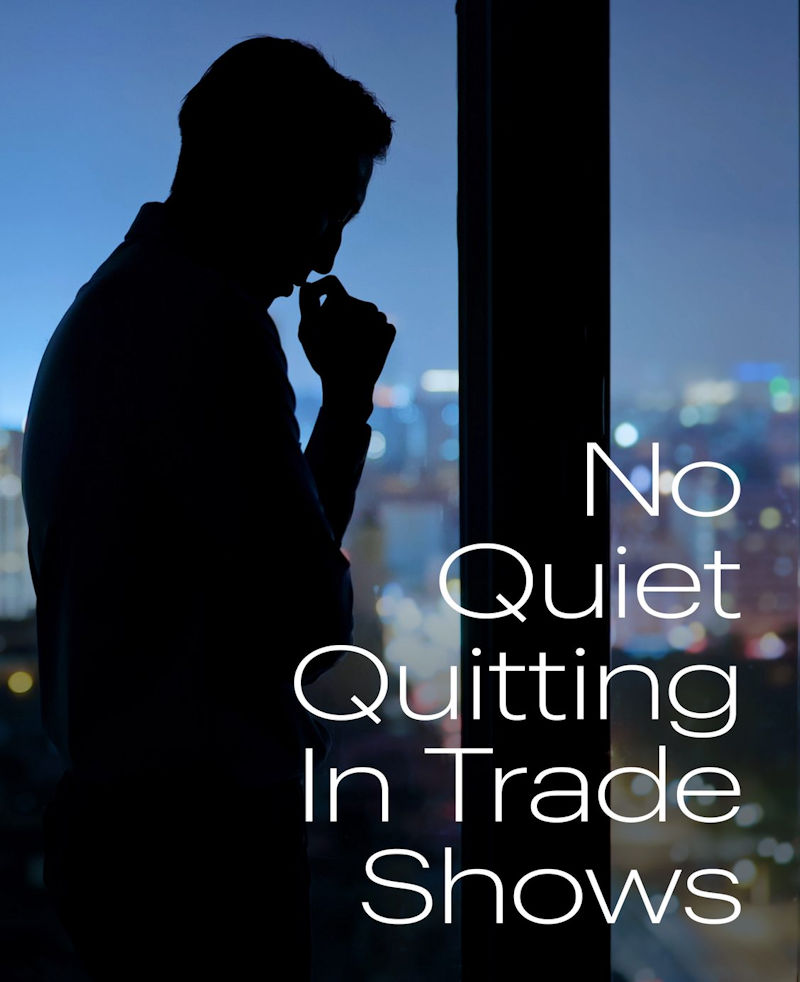
There’s no crying in baseball,” said Jimmy Dugan, aka Tom Hanks, in a League of Their Own. We’ve come up with our own version: “There’s no quiet quitting in trade shows.”
What is “quiet quitting”?
Just so we’re all on the same page., what is quiet quitting? It’s when employees put no more effort into their jobs than the absolutely necessary minimum. BTW, a 2022 Gallup survey suggested that at least half of the U.S. workforce consists of quiet quitters.
Our industry can’t survive ‘quiet quitting.”
“Quiet quitting” comes, interestingly but maybe predictably enough, as a product of the post-pandemic return to work. Many of us, myself included, went back to the show floor with unbridled enthusiasm. At first, I was overwhelmed; I forgot what being busy felt like.
But recently, I attended a show in Tokyo—right now, one of the hotspots in the APAC region for event activity—and several exhibitors were unhappy with their suppliers. Why? Because the people these exhibitors depended on to make them look good on the show floor only did the minimum. It was as if they decided, “That stand looks good enough”—not good, just good enough. Not meeting expectations. These same vendors lacked necessary information, important stuff like the names and phone numbers of essential show floor contacts. They didn’t know what questions to ask, and they floundered. In some cases, they asked for help from their competitors.
Why is this happening?
Who is responsible for this situation? This isn’t a blame game. When the pandemic hit, especially here in Asia, live events came to a halt for three years. Workers couldn’t sustain their and their families’ lives without income. This wasn’t true only in Asia—it was a worldwide phenomenon. Some called it the great resignation, but in fact, trade show and exhibition workers had to find other jobs. When the industry reopened, they had second thoughts about going back to the show floor because they were suddenly aware of the vulnerability of live events. Or perhaps they were comfortable in new jobs and new industries that allowed them to work at home.
Now, as people are hired for exhibition industry jobs, jobs they take because companies in our industry need workers and people need employment, there is the possibility of ‘quiet quitting.’ Without a significant onboarding, we risk hiring people who only do the minimum. Our industry is built on the willingness to go the extra mile. We build partnerships, and we understand our clients’ expectations. Unlike other industries, ours doesn’t have a remote/in-office discussion going on; we travel, some of us more than others. Sure, a certain amount of ‘office work’—at home or in the actual office—is part of the job. The schedules, the paperwork, and the outreach to new clients. But there is an intensity to working in our industry that has to be in the DNA of the people we hire.
Sharing our passion
I’m thinking about people like me who have been in the industry for a long time and have seen serial change. One way or another, we have incorporated changes as the industry evolves. Sometimes we resisted the change, and sometimes we embraced it. And that is what is at the heart of the matter and what the ‘quiet quitters’ are missing: our enthusiasm and our passion.
When we hire new, usually young, people to take the place of those who have retired or taken jobs in other industries, we owe it to them and to ourselves to find a way to get them excited about what we do. We need to show them the big picture, from concept to shop to show floor. We can’t expect our new hires to pick up on our ‘can do’ attitudes if we don’t have an onboarding process, which is very different from showing them where the coffee machine is. We want them to realize that the end product of our work is a happy client, not simply an exhibit on the show floor.
I had people who gave me this type of guidance, who mentored me and gave me feedback about the way I was doing things: the way I was interacting with customers, the way I might have been cutting a few corners, the way I worked with the shop. I needed that—and so does our current crop of new hires in the industry. Not receiving constructive feedback when you’re starting in a new industry is the first step toward quiet quitting. It leads to busyness for the sake of busyness—like spending too much time on their computers– in the hope that someone notices what they’re doing.
The Future Workforce
Productivity is important, but engagement and collaboration are more important. Those of us who have longevity in the industry know this issue must be addressed. For example, the Experiential Designers & Producers Association (EDPA) is putting considerable energy into its Future Workforce initiative. On a global scale, the International Federation of Exhibition & Event Services (IFES) has its own program to encourage and develop a new workforce, its talent team. But we need to inspire the people we’re hiring right now. Expectations are higher than ever before, and we need to meet them!


Comments are closed.